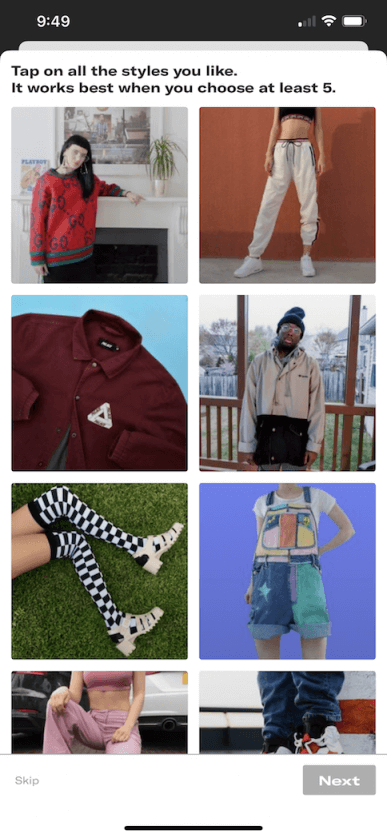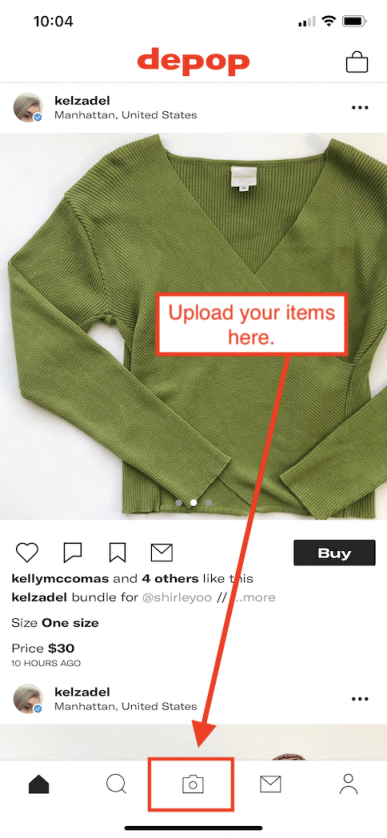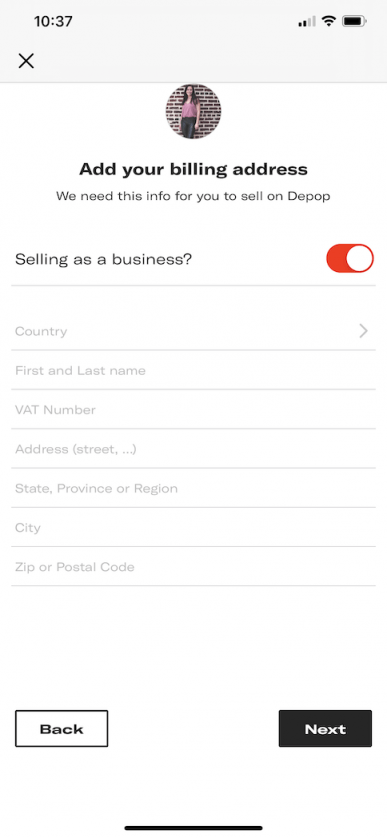Depop is a social shopping app for used fashion items. They charge a 10% commission fee when you sell on their platform, but make getting started with your shop incredibly easy.
It competes with other social selling apps like Poshmark and even Instagram, and has been described as a combination of Instagram and eBay.
Yet unlike eBay, Depop has a core focus on younger users, encouraging them to dive into the entrepreneurial world and “disrupt the fashion industry”.
They are one of the easiest platforms to get started with, especially because there’s not a lot that goes into setting up your Depop profile. There’s no extensive shop design or customization.
In fact… you can get started in under five minutes.
But like every option, Depop may or may not be the best fit for you depending on your product and goals.
Here’s a few reasons that you might want to start with Depop (and continue with this guide) –
- You want to get started for free.
- You want the convenience of selling directly from an app.
- You have items in your closet that you want to sell quickly and easily.
- You want to get a few initial sales before fully investing in your fashion business.
- You want a platform with built-in visitors.
- You are likely to have low volume of sales in the beginning.
Here’s a few reasons that you might not want to start with Depop –
- You want to build your own store with your own custom domain & design.
- You want to control your branding.
- You product does not conform to Depop’s guidelines.
- You want to cross-sell and upsell.
If Depop does not seem like the best fit – then you’ll be interested in my guide to the best ecommerce platforms.
Otherwise, let’s dive into the guide.
Setting Up Your Depop Profile
In order to start selling on Depop, you’ll need to download the app and set up your account. The set up is incredibly easily — and is definitely geared toward those buying more than those selling.
After you download the app and create your log in (or log in with Google or Facebook), Depop has you select at least five styles you’d like to shop in order to match you with sellers who offer looks you like.

From there, Depop recommends shops that match your selected styles for you to follow. Once you follow the shops, their items appear in your main feed, which is a great way to get visibility with new users as a seller!

Set Up Your Shop
Once you set up your account, it’s time to set up your shop. From the feed, click the camera button on the bottom of your screen, then click “Get Started”.

From there, Depop has you select a profile picture that showcases what type of style you’ll be selling on your shop. You’ll want to make sure your profile picture is high quality and shows the type of products your followers can expect to find on your shop.
Next, you’ll create a shop intro that tells your buyers about what you’re selling. Depop limits you to 128 characters, so be sure to be concise and specific about what your shop offers.

Next, Depop asks you to link to your social media profile. They suggest Instagram, which is a great place to showcase your fashion style and show buyers you’re legitimate.
Then, you’ll connect your PayPal account and fill out your billing address. You can select to run your store as a business, which changes your billing address information to be business-specific.

Now you’re ready to add a product and get selling!
Adding Your First Product
Once you have your profile set up, it’s time to upload your first product. Again, the process is incredibly quick and simple.
But before you list your product, you’ll need a few things first.
First, it must be a fashion / accessory item.
You’ll also need…
- High-quality photos or videos of the product (Depop recommends eye-catching photos and videos and has tips here).
- A product description that gives details (i.e. the condition of the product if used, the brand, and the style).
- Five hashtags so your product can be found (i.e. the brand your product belongs to)
You’ll also need to fill in the location (this allows your item to appear for nearby shoppers), product category, delivery, and price.

Once you have your first product uploaded, your shop is officially ready for business.
If you want to add more items to your closet before you start marketing, you’ll simply repeat the process above by navigating to Camera icon at the bottom of your screen.
Selling on Depop
Now that you’ve taken care of the logistics and have started adding items to your closet, it’s time to start actually selling your items.
Setting up your shop doesn’t guarantee sales. As of 2019, Depop has over 15 million active users, and that doesn’t even include your competition across other platforms.
And yet – you also have an instant market within a click. Your job is to decide who exactly you are selling to and where you can market to get their attention – and the answers to those questions will drive your marketing direction/campaign.
On Depop
The biggest benefit of Depop is that they have their own audience of Depop shoppers. With over 15 million users, you have a built in audience.
Think of it like getting a stall at a popular farmer’s market – people are coming to the destination. You simply have to get their attention once they are there.
Depop Search
The biggest opportunity on Depop is t0 get visits from Depop searches. Depop’s search engine is very different from general web search engines like Google or Bing. They have their own algorithm and data to drive their search.
Depop recommends a few best practices to make sure you show up in their search
- Use relevant hashtags, brand names, and descriptions
- Use high-quality photos
- Make sure you have your location listed for the product, so it shows up locally for those near you
Depop also has an Explore page, where their editorial team picks featured content to show. You can read more about how those listings are selected here.
On Social Channels
Another benefit of using Depop is that Depop listings and shops work very well on social platforms.
On Instagram
Instagram and Depop is a match made in marketing heaven.
Instagram is becoming increasingly more pay-to-play and doesn’t allow direct links in your posts (you either have to promote with a button to your listing OR link to your closet in your bio). However, description you write and photo that you take should work well on Instagram, especially given Depop itself is structured very similarly to Instagram.
Plus, with built in “Share on Instagram” capabilities in the Depop app, it’s easy to share your listings directly to Instagram without much hassle.
On Pinterest
Like Instagram, Pinterest and Depop are a match made in marketing heaven. Every description you write and photo that you take should also work well on Pinterest.
You can share individual listings, or create an entire board dedicated to your closet.
Pinterest is also a great place for marketing research and spending on promoted pins.
Here’s Depop’s guide to promoting like a pro, and another great resource on Pinterest marketing.
On Facebook
Yes – Facebook is increasingly “pay to play” if you are a business. If you rely solely on your business page’s organic likes for sales – you won’t get much visibility (and if you only share your listings on your personal page, you won’t be able to promote them beyond your friends and family).
But Facebook offers incredible paid options for business pages. You can create extremely targeted audiences and test your ads on a very little budget.
Twitter / Others
There are dozens of niche social networks to market your products. The key is to go where your audience is. And that goes back to deciding who exactly you are selling to (again, keep in mind Depop’s targeted audience. This is a group that love social platforms like Instagram).
It might be Wanelo, Polyvore or Instagram. It might be Twitter or Reddit. It all depends on your audience and product.
Other Channels
Once you go beyond Depop & social networking – you’ll need to start thinking about your domain & your long-term brand.
And once you start building your brand via organic search, paid media and PR – you want to make sure that you are building your brand and not Depop’s brand.
You’ll want external links to go to your domain. You’ll want ads to point to your domain with your own analytics & tags in place. You’ll want your PR mention to send people to your website with your experience.
But you don’t have to start right way – you can understand and keep these channels in mind while you start your shop and build from there.
I wrote a complete marketing plan for ecommerce here if you want to bookmark it for reference.
Organic Search / SEO
Your Depop listings will be indexed by Google/Bing. You may get traffic from Google/Bing – but it’s unlikely.
Because of the competition you’re unlikely to rank in Google for product terms with volume (ie, “Used Louis Vuitton Bag”). A search like that may bring you to the Depop search page, but not to your listing directly (and with so much competition for Depop, it’s unlikely).
And niche terms that you could rank for are typically Depop-specific and likely have a low search volume (i.e. Depop vintage tees).
Either way, it’s a large and profitable channel to plan for, and optimizing your listings for Google will also make optimize them for other channels, and help you prepare for if/when you create your own brand presence independent of Depop.
PPC / Paid Media
You shouldn’t plan to run paid media to your Depop store — it’s not a viable long-term strategy since you can’t add your own analytics or conversion tags to your listing.
Since most ecommerce sales are “multi-touch” (ie, people leave and come back later to purchase) – you should be careful about spending too much on either direct response or awareness ads.
However, you absolutely can use data from Depop (like which items sell best and to who) to inform future PPC campaigns that you run for your own website.
Growing Your Brand Beyond Depop
Depop is a great place to start selling your fashion items. But what about when you want to grow your own brand? If you’re a boutique, how do you expand?
You may want to go beyond Depop’s shop limitations, implement a custom design or just get away from transaction fees.
If you’re ready to start your own ecommerce store – here’s the typical growth path.
Getting your own domain
A custom domain is the foundation of your brand online. You can purchase one from Namecheap or GoDaddy for future use. In fact, you can even set up a “redirect” so that your custom domain can go directly to your Poshmark closet in case you aren’t ready to think about a full-blown website yet – but you don’t want to lose your domain name.
Remember, you won’t be able to use a custom domain ON the Depop platform — you can only redirect to your Depop URL.
Building a full ecommerce store
Many Depop sellers launch their own ecommerce store on their own custom domain. They’ll keep their Depop closet – but treat it as an additional marketing channel to sell to those buyers who are on Depop.
There are a wide-range of solutions – all of which are out of the scope of this guide. Here are the resources that I’ve put together –
- Buzzfeed-style Quiz on the Best Ecommerce Platform for You
- Setting up an ecommerce store with WordPress & WooCommerce
- Pros & Cons of using Shopify for an online store
Expanding other marketing channels
Once you’ve built your ecommerce store with your own domain name, you’ll have a wide-range of options to grow your store. Here are some of the resources that I’ve put together.
- Inbound Ecommerce Marketing Plan
- Website Data To Track or Lose Forever
- Using Pinterest for Marketing Research
- Ecommerce Guide to Free Shipping
Next Steps
So that’s a lot of information – but like any large project that you want to do well, you simply have to tackle it in small chunks.
- Start by setting up your Depop profile and filling out your account information.
- Upload your first product.
- Get initial sales & feedback.
- Begin planning, improving and growing with an eye on your end goals.



